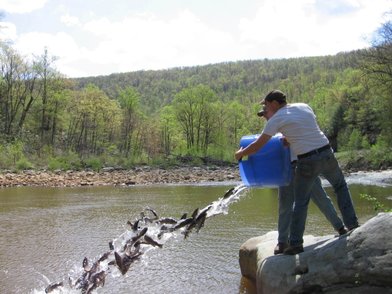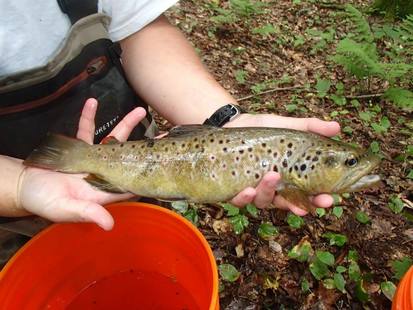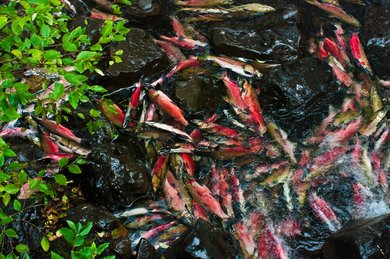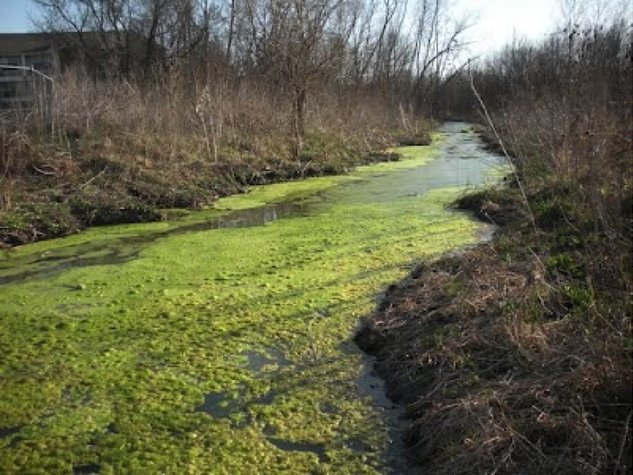 Buckets, tubs nets, and flumes...there's a lot of effort involved in stocking millions of fish. Photo courtesy of maryland.gov. Buckets, tubs nets, and flumes...there's a lot of effort involved in stocking millions of fish. Photo courtesy of maryland.gov. In the next few weeks, millions of trout (nearly 4.6 million in Pennsylvania, alone) will be stocked nationwide to improve and encourage angling opportunities. We all have opinions on fish stocking. And, if you’re like me, those opinions may not be so cut and dry. Native vs. nonnative. Stream location. Source population. Angling pressure. It all weighs into what you believe is the “right” choice for a particular stream. But, if you’re also like me, your opinions about stocking probably focus mostly on the fish. Will the stocked fish compete with the native fish? What happens if the stocked fish start reproducing in areas they are released? Sometimes we might extend our thinking to other organism, such as how adding more fish to a stream could impact the abundance of macroinvertebrates (i.e., food), which could ultimately decrease fish growth. It’s not too often we think about how fish stocking could affect an entire ecosystem. And, when we do, it usually still revolves around organism-level effects (such as declines in bats, birds, and spiders with nonnative fish stocking…a story for another day). But, what about the effects of stocking on, say, nutrients? Thinking about nutrients can be a little difficult because you can’t usually see them, or their effects, directly. But, flowing through the water are microscopic minerals and particles that are the building blocks for life. You’re probably more familiar with this concept than you realize- when you fertilize your garden you are adding, among other things, the nutrients phosphate and nitrogen to speed up growth. In streams, these nutrients are floating in the water, and organisms, particularly algae and other plants, absorb them to grow. The amount of nutrients available can limit the number of plants, insects, fish, even terrestrial animals that an ecosystem can support. Natural ecosystem have evolved a tight network that maximizes nutrient use to support the most number of critters possible. And, generally speaking, we don’t notice nutrient problems until something gets out of balance. For example, algal blooms are the result of excess nutrients entering streams, often from runoff from urbanized areas. Too many nutrients leads to too much plant growth, which ultimately can lead to loss of oxygen in the water and death of aquatic life.  Look at all those nutrients! Look at all those nutrients! Now, let’s turn our attention back to the fish. You can think of fish (and any living organism, for that matter), as a super concentrated packet of nutrients. Body tissues are loaded with nutrients, and at any given moment fish are eating, absorbing, digesting, and secreting even more nutrients. So, if fish are concentrated packets of nutrients, what effect does stocking have on the balanced ecosystem? This question was addressed by a group of researchers from Cornell University who evaluated the effects of stocked, nonnative brown trout on stream nutrient levels. They specifically focused on forms of nitrogen and phosphorous- two of the most prevalent nutrients that can quickly become too abundant and decrease overall water quality. For starters, fish stocking results in immediate increases to ecosystem nutrients. If you add thousands of new fish bodies to an ecosystem, then you are also increasing the amount of nutrients, often by orders of magnitude. This is a pretty obvious conclusion, yet I had never thought about stocking in that way before.  Sudden death of trout with increased stream temperatures would result in a rapid increase to stream nutrients. This process already happens out west, when anadromous salmon return to streams to spawn and shortly thereafter die, leaving millions of carcasses sprawled along the streambanks. Photo from critfc.org. Sudden death of trout with increased stream temperatures would result in a rapid increase to stream nutrients. This process already happens out west, when anadromous salmon return to streams to spawn and shortly thereafter die, leaving millions of carcasses sprawled along the streambanks. Photo from critfc.org. Once fish are in the streams, they start excreting waste, and waste is full of nitrogen. Stocked fish excreted up to 85% of the total ecosystem nitrogen demand when, in comparison, native fish only excrete 0.5% of ecosystem demand. That difference is huge! And, with more nitrogen floating around streams, there is greater potential for nutrient imbalances that can harm fish. Interestingly, stocked fish didn’t excrete much phosphorous, and so there was no effect on that nutrient. From there, things get interesting. In this study, angler harvest, predation, and natural mortality resulted in quick removal of most stocked fish from the systems. So, the effects of stocking to nutrient loads were not long-lasting. However, what if those fish had survived? What if fish were stocked in a catch-and-release system? In this case, stocked fish have the potential to not only have long-term impacts to nitrogen, but also increase other nutrients through reproduction (fish eggs are very high in nutrients) and in death (fish carcasses are even higher in nutrients). Mortality is particularly important when considering that many trout are stocked in streams that get too warm in late spring and summer, meaning that stocked fish are predicted to all die around the same time of year. If those carcasses are all decomposing in spring, at roughly the same time as many plants are starting to come out of dormancy, then excess nutrients could increase growth of aquatic plants and cause declines in overall ecosystem health. The effects of stocking are somewhat limited in small streams where nutrient levels are already high, and so ecosystem processes are unaffected by the addition of even more nutrients. However, mid-reach rivers and lakes are often nutrient poor. Initially it might seem like stocking in nutrient poor areas is a great thing. But, remember, ecosystems have evolved to operate under their own natural nutrient levels, even when they are low. So, adding nutrients will open the door for growth of plankton and algae and, ultimately, loss of water quality (you may be sensing a theme, here). It may sound like I’m trying to convince you that fish stocking is bad. It’s not. At least not always. It’s just a very complex issue, and the complexities are a lot deeper than many, including myself, sometimes realize. So, hopefully this post just makes you think a little harder next time you see the trout stocking schedule for your favorite steam.
0 Comments
Leave a Reply. |
AuthorShannon White Archives
October 2018
Categories
All
|
The Troutlook
A brook trout Blog
Proudly powered by Weebly

 RSS Feed
RSS Feed